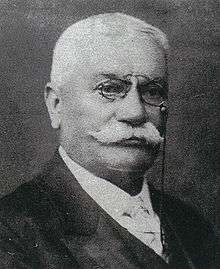Josef Victor Rohon

Josef Victor Rohon (7 May 1845, Temes-Buttyin – 15 March 1923) was an Austrian paleontologist and neuroanatomist.
He studied medicine, zoology and neuroanatomy at the University of Vienna, where he was influenced by Theodor Meynert (1833-1892), Carl Claus (1835-1899), Hans Kundrat (1845-1893) and Eduard Albert (1841-1900). In 1884 he graduated magna cum laude at Munich, where he spent the ensuing years conducting paleontological research. At Munich, he worked closely with Karl Alfred von Zittel (1839-1904), performing research that included anatomical studies of conodonts.[1]
In the spring of 1888, he relocated to St. Petersburg, where he served as a private tutor until 1895. Afterwards, he was an associate professor of histology (later for embryology) at the Karl-Ferdinands-Universität in Prague. In February 1903, he attained a full professorship of histology and embryology.[2]
His name is associated with "Rohon-Beard cells", defined as large, mechanosensory neurons found in the dorsal spinal cord of fishes and amphibians. Rohon-Beard cells are present only in the embryonic and young larval (tadpole) stages.[3][4]
Selected writings
- Das Centralorgan des Nervensystems der Selachier, 1877 - The central organ of the nervous system of Selachians.
- Über den Ursprung des Nervus vagus bei Selachiern mit Berücksichtigung der Lobi electrici von Torpedo, 1878 - On the origin of the vagus nerve in Selachians with consideration of the Lobi Electrici of torpedo fish.
- Untersuchungen über Amphioxus lanceolatus, 1882 - Studies of amphioxus.
- Über den Ursprung des Nervus acusticus bei Petromyzonten, 1882 - On the origin of the acoustic nerve of Petromyzontiformes
- Zur Anatomie der Hirnwindungen bei den Primaten, 1884 - Anatomy involving the gyri of primates.
- Über unter-Silurische Fische 1889 - On Lower Silurian fish.
- Über fossile Fische vom Oberen Jenissei 1889 - On fossil fish of the Upper Yenisei.
- Die Dendrodonten des Devonischen Systems in Russland 1889 - Dendrodonten from the Devonian in Russia.[5][6]
References
- ↑ Google Books The Genesee Conodonts: with descriptions of new species by William Letchworth Bryant]
- ↑ Biographical information based on a translation from an equivalent article at the German Wikipedia
- ↑ Reyes R, Haendel M, Grant D, Melancon E, Eisen JS (January 2004). "Slow degeneration of zebrafish Rohon-Beard neurons during programmed cell death". Developmental Dynamics. 229 (1): 30–41. doi:10.1002/dvdy.10488. PMID 14699575.
- ↑ Neurocomputing.org Earliest Tactile Sensory Neurons in Vertebrate Evolution
- ↑ Botanik und Zoologie in Österreich in den Jahren 1850 bis 1900: Festschrift by Anton Handlirsch, Richard Wettstein (Ritter von Westersheim)
- ↑ Google Search (publications)